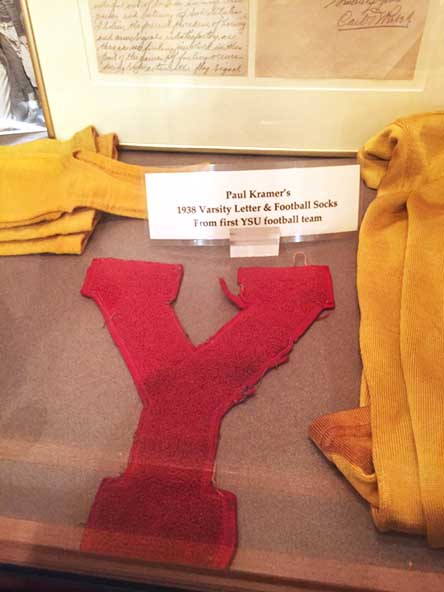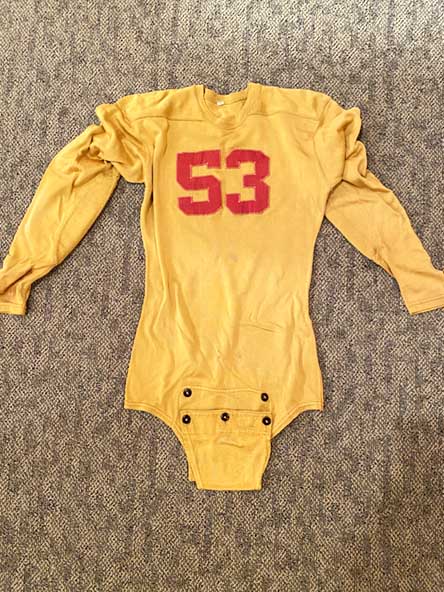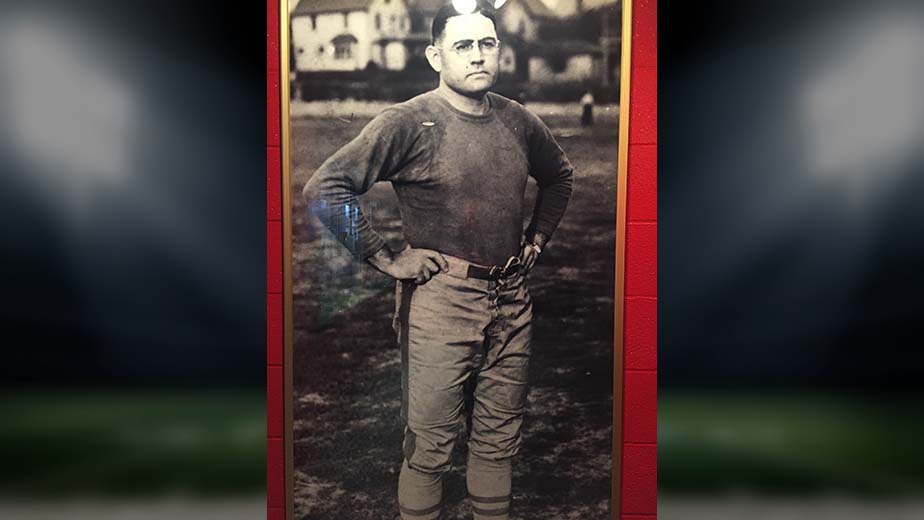YOUNGSTOWN, Ohio – Paul Kramer probably didn’t envision that one day his socks would be on display for thousands to view.
Yet Kramer’s pair of knee-high gold socks, along with his varsity letter from the inaugural 1938 Youngstown College Penguins football season, are among the hundreds of treasures that stand out in the Thomas F. Mosure Hall of Gridiron Glory at Stambaugh Stadium.
Together, these artifacts bring alive the narrative of Youngstown State University football, a program that has spanned 84 years and has produced legends both on the field and sidelines.

The hall opened in 2000 and is dedicated to the late Thomas F. Mosure, founder of Columbus-based engineering firm MS Consultants (which has an office in Youngstown) and a talented halfback from 1953 to 1955 for what was then Youngstown College. Mosure donated approximately $50,000 to restore underused space in the stadium concourse and build the exhibit and display area.
“I’m really partial to the older stuff,” says Trevor Parks, YSU sports information director. “When you look at some of the items from the 1930s and ’40s and the fact that they’re in such good shape, it shows the pride they took in being Penguins.”
The hall traces the history of the program from the first game in 1938 to the present. In between are mementos of players and coaches that have vaulted to fame, trophies celebrating the Penguins’ championship seasons, photographs depicting not only the transition of Youngstown State but college football as well, and homage to the contributions the team has made to the sport.
A neatly pressed penalty flag from the 1940s – then colored red and white and embroidered with a dedication to Irma Beede as the “Betsy Ross of Football” – is especially intriguing.
Beede was the wife of Dwight “Dike” Beede, who served as the Penguins’ head coach from the start of the program in 1938 until 1972. At her husband’s request, Beede sewed together what would become the first penalty flags in football history, using fabric from their daughter’s Halloween costume and a lead sinker from the coach’s fishing gear. The first penalty flags were used during an Oct. 17, 1941, game against Oklahoma City University at Rayen Stadium.
The exhibits rely on the generosity of alumni, former coaches or staff members from the football program or their families who have contributed hundreds of these artifacts, Parks says. “I’ve gotten to know a lot of those who have donated their stuff,” he says.
Many of these donors have died since the hall opened, but the athletics office still receives items from family members or from more recent players who want to preserve the Penguins’ heritage, says Rick Love, associate athletics director at YSU.
“We’ve added to it year to year,” he says. The entire northern and back walls are lined with display cases and filled with memorabilia and framed photos, including an original program from the inaugural Penguin football game dated Sept. 15, 1938 – a contest between Youngstown College and Geneva College played at South High School field. Stored and locked in cabinets beneath these cases are even more items, Love says.
“We get a lot of donations,” he says. “We talk to the football alumni group every year to see if there’s anything they’d like to donate.”
Along the southern wall hangs a panoramic timeline printed with photographs and texts showing YSU football history decade-by-decade. This display was added last year.
Cutting through the center of the room are stand-alone exhibits dedicated to players and coaches of special significance. Featured are jerseys, helmets and other items from prominent alumni who played in the National Football League such as Paul McFadden, Jeff Wilkins, Cliff Stoudt, Ron Jaworski and Tim Johnson.
McFadden, today the president of Youngstown State University Foundation, played for coach Bill Narduzzi at YSU and then went on to a successful NFL career between 1984 and 1989 with the Philadelphia Eagles, the New York Giants and the Atlanta Falcons.
“I donated my contract with the Eagles and an NFL game ball,” he says. His favorite piece in the collection is an original gold uniform with maroon numbers that player George Hardy donated from the 1938 season.
“It’s the most precious item, I think,” McFadden says. “It’s the only gold and maroon jersey that I’m aware of.”

Among McFadden’s duties, he says, was to have breakfast with members of the 1938 team once a month when he first joined the staff at YSU during the early 1990s. “I learned so much from them,” he recalls.
One player, McFadden remembers, played football for a full four years at Ohio State University before returning to Youngstown and enrolling in what was then Youngstown College. “He played for another two years at Youngstown,” he says with a laugh. “He told me it was different back then. They never kept track.”
Another center display is devoted to former YSU assistant coach Bob Dove, a South High School graduate who went to Notre Dame as a lineman during the 1940s under legendary coach Frank Leahy. An All-American his last two years at Notre Dame, he then spent nine seasons in the NFL. In 1969, he returned to YSU as an assistant coach under head coaches Beede, Rey Dempsey, Bill Narduzzi and Jim Tressel.
While at South High, Dove played alongside Sloko Gill, who in 1942 became the first Penguin alumnus to join the NFL, says local sportswriter and sports historian Greg Gulas. “He was the first NFL player from YSU,” he says. “He then became an assistant under Beede.”
Gulas says the Mosure Gridiron hall helps to preserve the great Mahoning Valley tradition of football. “There’s quite a history here,” he says.
This year is especially significant, YSU’s Parks says. Tressel, today YSU president, coached the Penguins between 1986 and 2000, earning four NCAA Division I-AA National championships during the 1990s.
Tressel announced in June that he would retire this February after eight years as president.
“Since this is his last year, we’ll be doing a Tressel-themed window out front,” Parks says. The front display will also honor the Penguins’ 1997 team, the last squad to win the national championship.
“It was very fortunate that Mr. Mosure made that gift to us,” McFadden says. “This really preserves the tradition of this team.”
Pictured at top: Dwight “Dike” Beede, who came up with the idea for the penalty flag.
